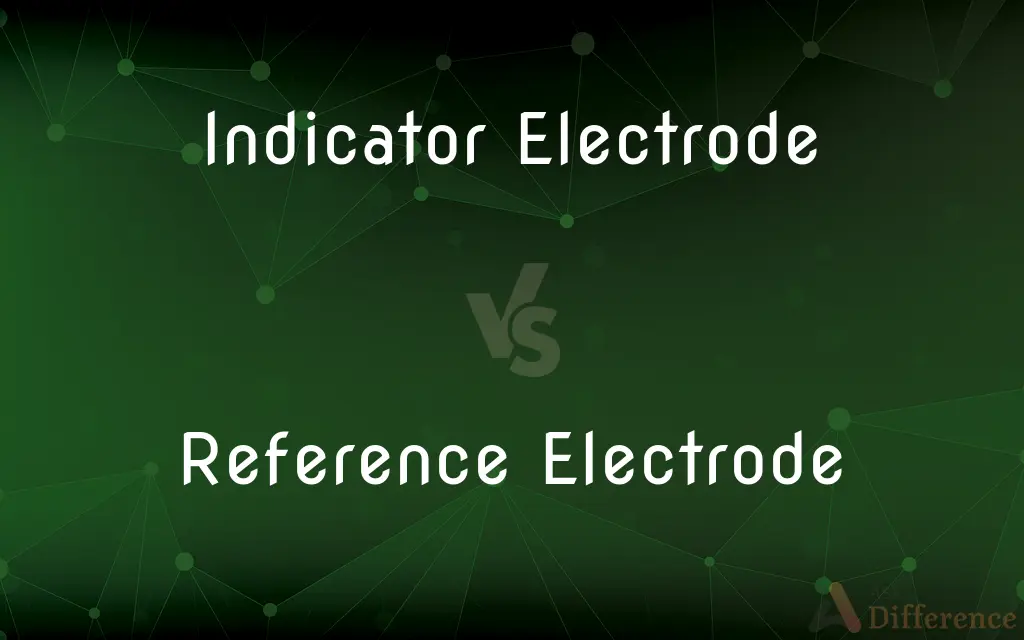Indicator Electrode vs. Reference Electrode — What's the Difference?
By Tayyaba Rehman — Published on December 5, 2023
Indicator Electrode detects analyte concentration; Reference Electrode maintains a stable, known potential for accurate measurements.

Difference Between Indicator Electrode and Reference Electrode
Table of Contents
ADVERTISEMENT
Key Differences
In the realm of electrochemical measurements, the roles of the Indicator Electrode and the Reference Electrode surface as pivotal yet distinctively separate. The Indicator Electrode primarily serves to identify the concentration of the analyte in question, registering its activity or concentration by producing a voltage signal. Alternatively, the Reference Electrode stands out by maintaining a stable and known electrochemical potential, allowing for a solid comparative baseline for the Indicator Electrode’s readings.
An essential attribute of the Indicator Electrode revolves around its inherent sensitivity to the analyte’s ions, which it translates into a measurable electrical signal. Meanwhile, the Reference Electrode exhibits stability and non-reactivity, abstaining from interference with the ion activity of the solution under study, thus maintaining a consistent potential that is unaffected by the composition of the analytical solution.
Further, in practical applications, the Indicator Electrode might be selective or sensitive to a particular ion, such as hydrogen ions in pH electrodes, establishing its utility in specific ion concentration measurements. Conversely, the Reference Electrode, by design, avoids selectivity, ensuring its unaltered potential is consistent, providing a reliable comparison point across various analytical conditions.
While the Indicator Electrode is integrally associated with the analytical function of detection and measurement, the Reference Electrode is predominantly associated with providing a steady point of reference in electrochemical cells. Consequently, the Indicator Electrode often interacts dynamically with the analyte, whereas the Reference Electrode remains steadfast and inert, ensuring the stability of its potential during the measurement.
Taking into account their functional distinctions, the Indicator Electrode and the Reference Electrode work collaboratively in electrochemical cells, wherein the former dynamically generates a potential relative to the latter’s stable potential, ensuring precise, reliable, and repeatable electrochemical measurements, while each maintaining their distinctive operational paradigms.
ADVERTISEMENT
Comparison Chart
Primary Function
Detects analyte concentration
Maintains stable, known potential
Reactivity
Sensitive and reactive to specific ions
Generally non-reactive
Stability
Can vary with analyte concentration
Remains stable across different conditions
Use Case
Ion concentration measurements
Provides a comparison point for measurements
Involvement in Analysis
Directly involved and dynamic
Indirect, stable, and constant
Compare with Definitions
Indicator Electrode
Indicator Electrode is essential for detection in electroanalysis.
Electroanalysis was conducted using an Indicator Electrode sensitive to H+ ions.
Reference Electrode
Reference Electrode is vital for measurement accuracy in electrochemistry.
The Reference Electrode’s stability guaranteed the reliability of the electrochemical data.
Indicator Electrode
Indicator Electrode provides a variable potential in use.
The potential of the Indicator Electrode altered with different analytes.
Reference Electrode
Reference Electrode allows comparison in electrochemical cells.
The Reference Electrode provided a comparison point for the detected potential.
Indicator Electrode
Indicator Electrode senses specific ion concentrations.
The Indicator Electrode showed a change when sodium ions were present.
Reference Electrode
Reference Electrode does not interact with the analyte.
Unlike the Indicator Electrode, the Reference Electrode remained non-interactive.
Indicator Electrode
Indicator Electrode translates ion activity into a voltage.
The voltage shift at the Indicator Electrode was noted during the experiment.
Reference Electrode
Reference Electrode is designed to be non-reactive with solutions.
Stability of the Reference Electrode was crucial for accurate measurements.
Indicator Electrode
Indicator Electrode can be selective towards certain ions.
The Indicator Electrode was specifically designed for calcium detection.
Reference Electrode
Reference Electrode maintains a constant electrochemical potential.
The Reference Electrode ensured a stable baseline during the test.
Common Curiosities
Is the Indicator Electrode usually ion-selective?
Yes, the Indicator Electrode is often selective towards a specific ion or a group of ions.
Why is the Indicator Electrode’s potential variable?
The Indicator Electrode’s potential varies as it is sensitive to changes in analyte concentration.
Does the Reference Electrode interact with the analyte?
No, the Reference Electrode does not interact with the analyte and maintains a constant potential.
Is the Indicator Electrode used in pH measurements?
Yes, a type of Indicator Electrode, called a pH electrode, is used to measure hydrogen ion concentration.
Can an Indicator Electrode work independently?
No, an Indicator Electrode needs a Reference Electrode to provide a comparative potential.
What is the main role of the Indicator Electrode?
The Indicator Electrode detects and measures the concentration of a specific analyte.
How does the Reference Electrode aid the Indicator Electrode?
The Reference Electrode provides a stable potential against which the Indicator Electrode’s potential is measured.
What ensures the stability of the Reference Electrode?
The Reference Electrode's design and materials ensure it remains non-reactive and stable.
Is the Reference Electrode specific to any ion?
No, the Reference Electrode is not ion-specific and maintains a consistent potential.
What characterizes the function of the Reference Electrode?
The Reference Electrode maintains a stable, known potential for accurate measurement comparison.
Can the Indicator Electrode measure any ion?
Not always, the Indicator Electrode is often designed to be selective towards particular ions.
Are Indicator and Reference Electrodes used together?
Yes, they are used together in electrochemical cells to measure and compare electrochemical potentials.
In what conditions is the Indicator Electrode used?
Indicator Electrode is used in varied conditions, depending on its type and intended ion detection.
Can a Reference Electrode detect ion concentrations?
No, the Reference Electrode does not detect ions but provides a stable reference point for measurements.
Why is the Reference Electrode’s non-reactivity crucial?
Non-reactivity ensures the Reference Electrode’s potential remains stable, ensuring accurate measurements.
Share Your Discovery

Previous Comparison
Bubble Sort vs. Selection Sort
Next Comparison
Iron vs. Cast IronAuthor Spotlight
Written by
Tayyaba RehmanTayyaba Rehman is a distinguished writer, currently serving as a primary contributor to askdifference.com. As a researcher in semantics and etymology, Tayyaba's passion for the complexity of languages and their distinctions has found a perfect home on the platform. Tayyaba delves into the intricacies of language, distinguishing between commonly confused words and phrases, thereby providing clarity for readers worldwide.
















































